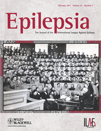Outcome of status epilepticus in children treated in the intensive care unit: A study of 302 cases
Summary
Purpose: The aim of the study was to evaluate the outcome of status epilepticus (SE) in children and to define predictors for morbidity, mortality, and SE recurrence.
Methods: The study included 302 children (age 2 months to less than 18 years; mean age ± SD 4.7 ± 4.2 years) with 489 episodes of SE. Etiology, treatment, and clinical and electroencephalography (EEG) features of SE and their impact on the outcome were analyzed. The outcome was classified into three categories: unchanged neurologic status, neurologic consequences, and lethal outcome. Univariate and multivariate Cox hazard regression analyses were used to define predictors of mortality, morbidity, and SE recurrence.
Key Findings: Neurologic status was unchanged in 235 children (77.8%) and neurologic consequences occurred in 39 patients (12.9%); case-fatality ratio was 9.3% and recurrence rate was 21%. Mortality was related to progressive encephalopathy, preexisting neurologic abnormalities, specific EEG findings, and generalized convulsive type of SE. Neurologic consequences were associated with younger age, progressive encephalopathy, duration of SE >24 h, prior epilepsy, and specific EEG findings. Multivariate analyses showed that etiology of SE and prior neurologic abnormalities were independent predictors of mortality, whereas younger age, etiology, and very long duration of SE were predictors of morbidity.
Significance: Outcome of SE in children is favorable in most of the cases, but mortality and morbidity rates are still high. Etiology and prior neurologic abnormalities were the main predictors of mortality, whereas the main predictor of morbidity was underlying etiology.




